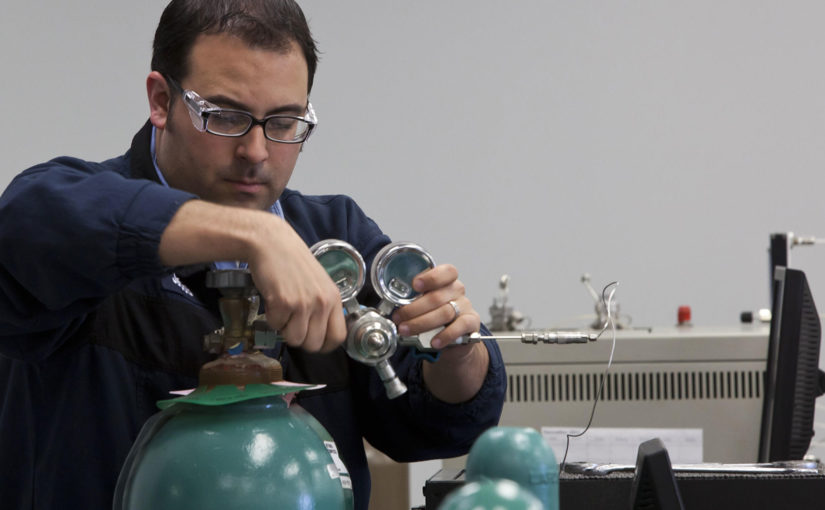Has this happened to you? Imagine you’ve got a project that needs to be completed this week, and the gases you need for the job arrive on your site—but the cylinder valve doesn’t match your regulator. Now you’re at an impasse, unable to move forward with your work and your deadline is in jeopardy.
It is important to be informed about the Compressed Gas Association (CGA) valve outlet connections assigned to each of your cylinders’ valves to avoid this type of situation in the future. Read on to get familiar with CGA and other valve outlet connections, develop a better understanding of their purpose and be able to plan ahead to ensure you have the right equipment to use your gas safely.
Creating a built-in security system for your cylinders
One of the ways the CGA has contributed to improved safety for compressed gas users is by implementing a standardized system that ensures cylinder valve outlet connections are different among gas families. The system intends to prevent incompatible gases from being connected improperly. The Compressed Gas Association was established in 1913 to improve safety by creating technical specifications, standards, training content and educational materials for compressed gases.
How CGA valves improve safety
Forcing a connection between valves on gas cylinders and delivery equipment with different CGA Connection outlets that are not intended to be used together is dangerous. Some hazards that can be created when improperly working with compressed gases include mixing incompatible gases, adverse chemical reactions between gases and equipment materials of construction and cross-contamination.
The proper use of CGA outlet connections on cylinder valves and delivery system equipment greatly reduces these hazards. The CGA connections make it difficult to remove gases from a cylinder without a matching connection.
Gases and gas delivery equipment are necessary in thousands of applications around the world. However, they can pose serious hazards when misused or when accepted CGA guidelines are not followed. Here are a few things to keep in mind before you begin your next job requiring the hookup of cylinder gases:
- Always verify that the gas cylinder CGA valve outlet connection matches the gas delivery equipment CGA connection.
- Always use gas delivery equipment that has not been modified.
- Always assure that the CGA connection fittings are in good operating condition.
- Always make sure fittings are clean of impurities, especially from oils and other hydrocarbons.
How to find your CGA
There are two primary places you can look to ensure all of your CGA connections are matching. Always make sure your fittings match before attempting to hook up your cylinders.
- On your cylinder valve: Airgas cylinder valves and CGA nuts are usually stamped with the CGA connection. The stamp may be on the ring below the valve handle or stamped into the side right above the cylinder thread inlet.
- On the regulator or changeover: The stamp is located on the CGA nut.
CGA outlet connections including medical-specific connections and Diameter Index Safety System (DISS) high integrity outlet connections are enumerated in CGA V-1, Standard for Compressed Gas Cylinder Valve Outlet and Inlet Connections. This CGA publication contains information on other international valve outlet connections.
Understanding the CGA guidelines before you begin your work can help you avoid frustration. Making sure your cylinder connections are correct can help prevent potential accidents caused by unsafe or incompatible connections.
Need help deciding which equipment you need for your process? Connect with us >
How CGA valve outlets are organized
In most instances, groups of gases that share the same characteristics or hazards share CGA connections:
CGA 580: Inert gases, such as nitrogen, argon, helium, neon and krypton
CGA 350: Flammable gases such as hydrogen, methane, ethane
The CGA connection standard numbers are followed by a multi-part, sequentially-listed descriptive code that includes the following characteristics:
1. Outside diameter of valve threads
2. Threads per inch and thread size
3. Left-hand or right-hand thread
4. External or internal threads
All of these features are employed to reduce your risk of unsafely connecting the wrong gases and equipment into your process.
A unique connection type called the Diameter Index Safety System (DISS) was developed for medical and ultra-high purity gases. DISS valve connections differ from standard CGA valve connections in that they have threaded, face-to-face connections.
This additional connection was developed to minimize outside impurities entering the gas stream.
Navigating CGA valve outlets connections abroad
Since different countries have different governances and specifications for cylinder connections, if you are purchasing gas from an international supplier, check the connections when you order to determine which type of connection the cylinder demands. It’s the cylinders and valves that matter. For example, Germany uses DIN, Britain uses BS, the Netherlands use NEN and Japan uses JIS. It is very important to understand the specifications being used by the country you’re purchasing from when purchasing gases and equipment outside of the US or Canada.
Ask an Airgas expert for more information >
